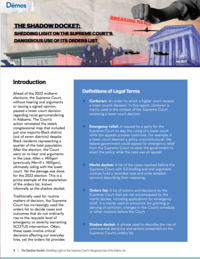What is the Shadow Docket?
First coined in 2015 by Professor William Baude, the Faculty Director of the Constitutional Law Institute at the University of Chicago Law School, the shadow docket references the controversial use of the Supreme Court’s orders list. Rulings made via the Court’s shadow docket represent a sharp departure from the usual procedure for deciding broad impact. These rulings are often issued with little to no explanation. Further, cases considered via the shadow docket are decided without briefing or oral argument, and they are often unsigned. While the shadow docket lacks the rigor and transparency demanded of cases on the merits docket, decisions are equally binding, and the consequences are just as serious.
Until recently, orders from the shadow docket with major substantive implications were generally few and far between. Emergency relief is intended to be rare. To prevail on an application for emergency relief, often a request to put the lower court’s decision on hold, the applying party must show that the lower court’s ruling would cause “irreparable harm” if allowed to stand. Over the last few years, the frequency of decisions made on the orders list has accelerated considerably.
Arguably, the Court exploits the rules governing emergency review when it grants relief in cases where irreparable harm has not been established. Justice Elena Kagan explicitly chided her colleagues on the overuse of the shadow docket after a 2021 ruling that blocked implementation of the Clean Water Act:
By nonetheless granting relief, the Court goes astray. It provides a stay pending appeal, and thus signals its view of the merits, even though the applicants have failed to make the irreparable harm showing we have traditionally required. That renders the Court’s emergency docket not for emergencies at all. The docket becomes only another place for merits determinations—except made without full briefing and argument.
The Supreme Court has reduced the number of cases it heard on the merits to around 60 annually, while increasing the number of cases it decide on the shadow docket. The absence of opportunities for detailed briefing, oral argument, or amicus briefs from interested third parties further exacerbates the lack of transparency. This omission of documentation is even more problematic as orders typically lack substantive explanation of the justices’ decisions.
The absence of transparency and explanation can also cause confusion for lower courts attempting to interpret these rulings with little guidance. This can lead to contradictory decisions and an inconsistent application of the law across jurisdictions.
Further, Supreme Court justices are not required to sign the orders, which can often lead to confusion as to who is in the majority and why. Referencing a decision to deny a stay of execution in 2014, Justice Ruth Bader Ginsburg said, “When a stay is denied, it doesn't mean we are in fact unanimous.” Even on the occasions when a justice does publish an opinion describing their thinking about an item on the orders list, only the author is required to sign their name, while the public remains in the dark as to who concurred.
Increasing Use of the Shadow Docket
Professor Stephen Vladeck, the Charles Alan Wright Chair in Federal Courts at the University of Texas Law School, has called 2017 “an inflection point” for the use of the shadow docket. Unlike the Bush and Obama administrations, the Trump administration sought emergency relief 41 times, with the Supreme Court granting relief in 28 of those cases. In contrast, Bush’s Solicitor General only sought emergency relief five times, while Obama’s sought emergency relief three times. The Trump administration’s aggressive strategy of using emergency review to combat unfavorable injunctions that blocked Trump’s harmful policies accounted for part of the rise in emergency requests to the Court.
During his 2021 testimony before the House Committee on the Judiciary, Vladeck said the increasing use of the shadow docket was due to a “confluence of factors,” including the Court’s change in ideological composition.
“Indeed, it is no coincidence, in my view, that the brakes have truly come off since the retirement of Justice Kennedy and the death of Justice Ginsburg. Nor can it be denied that this uptick has enormous real world consequences,” Vladeck told House Committee members.
During the Trump administration, the Supreme Court worked in lockstep to enable an extreme agenda through increased use of the shadow docket, notably in immigration policy. During a single four-year term, the Trump administration banned travel from several majority-Muslim countries, blocked migrants from asylum eligibility, and created the “Remain in Mexico” policy that illegally prevented asylum seekers from entering the country while waiting for a hearing in U.S. immigration court. In all three examples, lower courts blocked the harmful policies, citing their capriciousness and cruelty—only for the Supreme Court to overturn the rulings on the shadow docket.
Harmful shadow docket rulings regarding immigration have continued into the Biden administration, although now SCOTUS has begun refusing the Biden administration’s requests for emergency relief. First, the Supreme Court forced the Biden administration to reinstate the “Remain in Mexico” policy. Then, in 2022, the Supreme Court blocked a lower court ruling that ended the use of Title 42, a Covid-era pandemic policy that allowed the United States government to expel migrants under the guise of stopping the spread of Covid-19. In this case, Chief Justice Roberts refused to grant emergency relief, and allowed the policy to continue while the case is ongoing—a disastrous outcome for migrants and their communities.

